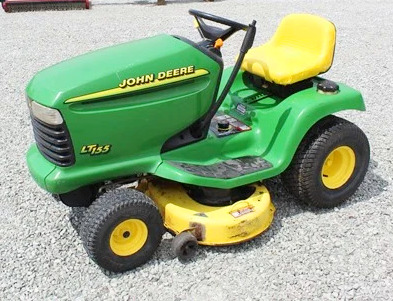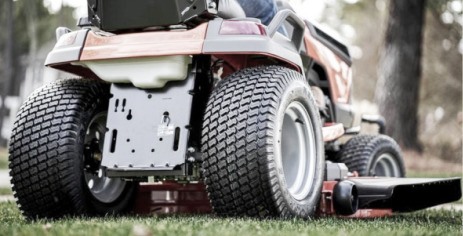________________________________________________________________________________________
John Deere LT155 Troubleshooting
 The
John Deere LT155 is a 2-wheel drive lawn tractor from LT-series. This model was
manufactured between 1998 and 2001. The John Deere LT155 tractor is powered by
Kohler Command CV15S vertical shaft four-cycle single cylinder air-cooled
gasoline engine.
The
John Deere LT155 is a 2-wheel drive lawn tractor from LT-series. This model was
manufactured between 1998 and 2001. The John Deere LT155 tractor is powered by
Kohler Command CV15S vertical shaft four-cycle single cylinder air-cooled
gasoline engine.
A 26.1 cubic inches (426 cc) engine has a cylinder bore of 3.6" (90 mm),
piston stroke of 2.64" (67 mm), rated power of 15 hp (11.2 kW), and
maximum torque of 33.2 Nm (24.5 lb-ft) at 2400 rpm. The John Deere LT155
is fitted with two transmission options: Dana 4360 mechanical
transmission with 5 forward and 1 reverse gears, or Tuff Torq K51A
hydrostatic transmission with infinite forward and reverse gears. Max.
travel speed (forward/reverse): 5.5 mph (8.8 km/h) and 3 mph (4.8 km/h).
The John Deere LT155 is equipped with a manual steering system,
mechanical disc brakes, 15x6.00-6 front tires, and 20x10.00-8 rear
tires. The wheel base is 48" (1210 mm). The tractor is compatible with
38", 42" mid-mount 2-blade mower deck with cutting height of 1.0-4.0"
(25-102 mm) and manual lifting system, and 42" front-mount blade.
| Engine Troubleshooting |
| Engine starts hard or doesn't start |
| Gas tank is empty - Fill fuel up |
| Incorrect fuel grade - Use quality fuel |
| Clogged fuel system - Remove clogging |
| Defective spark plug wire connection - Inspect the spark plug wire connection, replace or repair |
| Spark plug is defective - Change spark plug |
| Fuel filter is clogged - Fuel filter needs to be replaced |
| Defective safety switch - Replace if required |
| Problems with carburetor adjustment - Adjust as required |
| Low compression - Check and replace worn parts |
| Damaged or incorrectly adjusted choke cable - Replace cable or adjust correctly |
| Air intake grill is clogged - Clean and wash as required |
| Ignition system failure - Check ignition and replace faulty components |
| Throttle cable is stuck or faulty - Change or service the cable |
| Dirty air filter element - Change or clean air filter |
| Clogged or damaged fuel pump - Clean or replace fuel pump |
| Engine starts and then shuts off |
| Spark plug is damaged - Change spark plug as required |
| Clogged or defective carburetor - Carburetor needs to be replaced or cleaned |
| Ignition coil is faulty - Install a new ignition coil |
| Valve springs are worn or loose - Change valve springs |
| Valves are stuck - Valves must be cleaned |
| Not enough engine oil - Fill the crankcase with engine oil |
| Engine is overloaded - Reduce load |
| Cooling fins are blocked - Wash or clean as required |
| Carburetor mixture is too lean - Set the carburetor properly |
| Ignition timing is wrong - Ignition timing needs to be adjusted correctly |
| Wrong valve setting - Set the valves correctly |
| Engine knocking sound or abnormal noise |
| Low octane gasoline - Use proper fuel |
| Engine is overloaded - Load reducing required |
| Engine oil level is low - Add oil to the engine crankcase |
| Low idle speed setting is incorrect - Adjust idling as required |
| Dirty or defective fuel pump - Clean or replace fuel pump |
| Crankshaft or main bearings wear - Crankshaft or bearings need to be replaced |
| Valve clearance is improper - Check and adjust |
| Damaged piston rings or cylinder bore - Change defective components |
| Carburetor is improperly adjusted or clogged - Adjust carburetor properly or service it |
| Air filter element is plugged - Clean or change air filter |
| Clogged or damaged fuel pump - Test fuel pump and replace if necessary |
| Defective ignition - Inspect ignition system and change failed components |
| Cylinder head gasket is worn - Install new cylinder head gasket |
| Burned or stuck valves - Service or replace valves |
| Worn or defective push rod - Install a new push rod |
| Damaged cylinder block parts - Replace defective parts |
| Engine using too much gasoline |
| Throttle did not open fully - Replace or adjust throttle cable |
| Incorrect carburetor main jet adjustment - Adjust it correctly |
| Loose or defective spark plug - Change or re-tighten spark plug |
| Valves are worn, burned or stuck - Service or replace valves |
| Worn sleeve, piston, or rings - Replace faulty components |
| Incorrect valve clearance - Adjust valve clearance according to specifications |
| Damaged seals or gaskets - Defective components must be replaced |
| Valve stems and guides are worn - Replace the valves |
| Piston rings are seized or worn - Have piston rings replaced |
| Cylinder liner or piston is scuffed - Check liner and piston, replace as required |
| Plugged breather hose or pipe - Clean or replace |
| Transmission Troubleshooting |
| Difficulty shifting gears |
| Gear shift linkage is rusty or worn - Lubricate or replace the shift linkage |
| Shift forks are worn or damaged - Change defective shift forks |
| Worn gear shift mechanism - Replace worn components |
| Insufficient fluid supply - Fill the transmission housing with fluid |
| Transmission oil is contaminated - Fill up with fresh transmission oil |
| Gears or bearings are worn - Change faulty parts |
| Transmission jumps out of gear |
| Gear shift lever is improperly installed or bent - Replace or install shift lever correctly |
| Worn or damaged gear teeth - Install new gears |
| Shift rods or shift forks are worn - Replace damaged rods or forks |
| Drive belt/shaft is defective or improperly adjusted - Replace belt/shaft or adjust it |
| Incorrect clutch/brake adjustment or worn clutch/brake - Replace brake/clutch or adjust it |
| Drive sheave is damaged or worn - Install a new sheave |
| Hydrostatic Transmission Troubleshooting |
| Hydrostatic transmission is excessively noisy |
| Worn or out of adjustment speed control linkage - Adjust or change linkage |
| Excessive loading - Load needs to be reduced |
| Fluid is contaminated or fluid level is insufficient - Fill to required level or change the fluid |
| Worn or defective transmission components - Replace or repair defective components |
| Stuck or worn shift linkage - Linkage need to be replaced |
| Hydrostatic pump is stuck or worn - Repair or replace pump |
| Misadjusted or faulty transmission shift control components - Replace or adjust as required |
| Low oil level - Fill up the transmission oil |
| Drive sheave is damaged or worn - Change sheave |
| Shift linkage is damaged or unadjusted - Replace or adjust linkage |
| Bent or unadjusted speed control pedal linkage - Adjust or replace linkage |
| Transmission gaskets or seals are worn - Seals and gaskets need to be replaced |
| Final drive shaft leaks - Shaft seals need to be changed |
| Transmission case is cracked - Replace defective case or transmission assembly |
| Mower Deck Troubleshooting |
| Excessive mower vibration |
| Clogged or damaged mower drive sheave - Change or clean sheave |
| Damaged or loose drive belt - Adjust belt tension or install a new belt |
| Unbalanced or warped cutting blades - Replace or balance blades |
| Loose blade bolts tightening - Tighten bolts as required |
| Discharge chute is constantly plugged |
| High mowing speed - Use a slower speed |
| Long grass - Adjust mower to lower cutting height |
| Engine rpm is too low - Choke is not fully opening |
| Cutting height is too low - Use a higher cutting height |
| Drive belt installed improperly - Check drive belt for correct installation |
| Clogged mower deck - Clean out the mower deck |
| Blades are not sharp - Blades need to be sharpened |
| Blades are worn or damaged - Replace the blades |
| Fast mowing speed - Need to slow down |
| Low cutting height - Change cutting height adjustment |
| Filled bagger - Clean bagger |
| Blades are scalping the grass |
| Lawn is not level or bumpy - Roll or level the lawn |
| Low cutting height - Raise the cutting height |
| Mowing speed is too high - Use a slower speed |
| Mower deck is not leveled properly - Level the deck properly |
| Blades are worn or bent - Replace the blades |
| Incorrect tire pressure - Correct tire pressure |
| Tires are not correctly inflated - Check and inflate the tires |
| Mower deck is not leveled properly - Adjust mower deck level properly |
| Excessive blade dullness - Blades need to be sharpened |
| Damaged or worn blades - Install new blades |
| Clogged mower deck - Clean out the mower deck |
| Damaged mower deck housing - Replace or repair the deck |
| Mower spindle is faulty or loose - Replace or repair the spindle |
| Electrical Troubleshooting |
| Battery cannot be charged |
| Electrical cable connections are loose or corroded - Clean or tighten connections |
| Faulty battery terminal clamps - Install new terminal clamps |
| Battery bad cell - Change the battery |
| Low battery voltage - Battery is drained, recharge it |
| Battery will not hold charge - Service battery or change it |
| Terminals are faulty or battery cables are disconnected - Check cables and replace or service terminals |
| Battery is low or faulty - Recharge or replace battery |
| Wiring is incorrectly connected or disconnected - Inspect wiring and connect correctly |
| Battery capacity is low - Battery is drained, recharge it |
| Spark plug faulty or incorrectly gapped - Clean and gap or replace |
| Starter motor or solenoid failing - Change solenoid or repair starter |
________________________________________________________________________________________
________________________________________________________________________________________
| Lawn and Garden Tractors Technical Specs |
 The
John Deere LT155 is a 2-wheel drive lawn tractor from LT-series. This model was
manufactured between 1998 and 2001. The John Deere LT155 tractor is powered by
Kohler Command CV15S vertical shaft four-cycle single cylinder air-cooled
gasoline engine.
The
John Deere LT155 is a 2-wheel drive lawn tractor from LT-series. This model was
manufactured between 1998 and 2001. The John Deere LT155 tractor is powered by
Kohler Command CV15S vertical shaft four-cycle single cylinder air-cooled
gasoline engine.